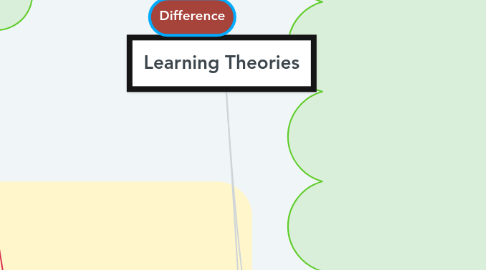
1. Student-Centered Learning
2. Teacher-Centered Learning
3. Difference
4. Similarity
5. Builds on Idea
6. Behaviourism
6.1. assumes that
6.1.1. Behaviour is Predictable and Measurable
6.1.1.1. through
6.1.1.1.1. Stimulus and Response- Mind as a "Black Box"
6.1.2. All behaviour is learned from the environment
6.1.2.1. through
6.1.2.1.1. Repetition and Reinforcement
6.2. is used for
6.2.1. Classroom Management
6.2.1.1. such as
6.2.1.1.1. Behaviour Modification- "Shaping"
6.2.1.2. can lead to
6.2.1.2.1. Competitive Environments
6.2.2. Motivation
6.2.2.1. such as
6.2.2.1.1. Gamification
6.2.2.1.2. Positive Expectations
6.2.2.2. can lead to
6.2.2.2.1. Loss of Interest
6.2.2.2.2. Addictive Qualities
7. Constructivism
7.1. Cognitive Constructivism
7.1.1. developed by
7.1.1.1. Jean Piaget
7.1.1.1.1. development is
7.1.1.1.2. learning occurs through
7.2. learning as
7.2.1. Active Construction of Knowledge Out of Previous Knowledge
7.2.1.1. emphasizes
7.2.1.1.1. Inquiry Learning
7.2.1.1.2. Active Problem Solving
7.2.1.1.3. Teacher as Facilitator
7.2.1.1.4. Student-Centered Activities
7.2.1.1.5. Situated Learning
7.2.1.1.6. Individual Differences
7.3. Social Constructivism
7.3.1. developed by
7.3.1.1. Lev Vygotsky
7.3.1.1.1. learning occurs
7.3.1.1.2. development is
8. Cognitivism
8.1. Social Cognitive Theory
8.1.1. developed by
8.1.1.1. Albert Bandura
8.1.1.1.1. Environmental Stimuli
8.1.1.1.2. Observational Learning
8.2. Cognitive Information Processing
8.2.1. conceives
8.2.1.1. Learners as Information Processors
8.2.1.1.1. through
8.2.1.1.2. neglecting
8.2.1.2. seeks to
8.2.1.2.1. Explain how the Mind Functions
8.3. Neuroscience
8.3.1. concerned with
8.3.1.1. Mapping Neural Functions onto Cognitive Behaviours
8.3.1.1.1. including
8.3.2. learning occurs by
8.3.2.1. Creating and Strengthening Neural Pathways
8.3.2.1.1. known as
8.3.2.1.2. accounts for
8.3.2.1.3. benefits from
8.3.3. informs practice by
8.3.3.1. Substantiating Existing Learning Theories with Neuroscientific Data
8.3.3.2. Teaching to both Brain Hemispheres
8.3.3.2.1. captures
8.3.3.3. Arousing and Maintaining Attention
8.3.3.3.1. through
8.3.3.4. Strengthening Memory Networks
8.3.3.4.1. through
8.3.3.5. Maintaining Motivation
8.3.3.5.1. through
8.3.3.6. Addressing Specific Difficulties
8.3.3.7. Alignment With How We Think and Learn
8.3.3.7.1. effective practices include
